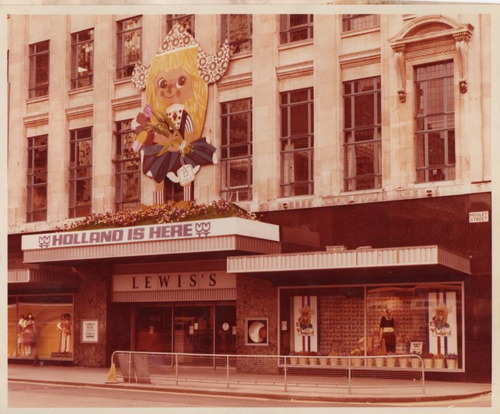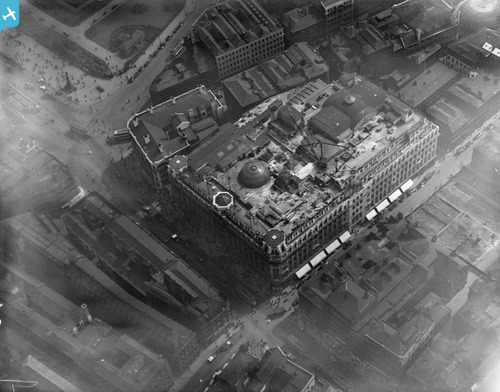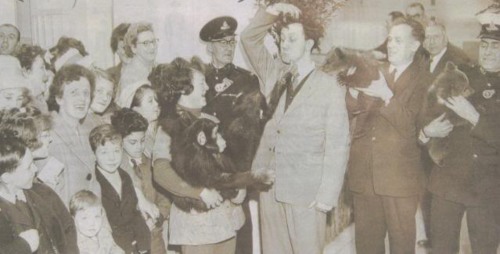WHAT'S HIDING ON THE ROOFTOPS?
WRITTEN BY Hayley Flynn
READING TIME: 7 minutes
What we know as Primark in Piccadilly was once home to Lewis's, and "if something happened it happened at Lewis's."
What we now know as the premises of Primark (the largest Primark in the world in fact) was originally built to house a Lewis’s Department store. By virtue of housing such a spectacular venture the building has some wonderful features that you wouldn’t expect to find when you’re fighting through the crowds on a sticky Saturday.
What’s hidden on the rooftop isn’t actually visible from the street but you can see on the Google image below there’s a large glass dome, an ornate feature that is no longer in view whilst in the building but once was an integral part of the magic of the Lewis’s store.
On the corner of Market and Moseley Street this particular branch opened in 1877 and closed as a Lewis’s in 2001 (though Lewis’s had actually gone into administration ten years prior to this).
The building is by architects Horton and Bridgford and was built in a French renaissance style with a grand corner tower (now removed).
The shop applied for an extension in 1915, buying up the Royal Buildings (the site of the Royal Hotel, where the football league was founded in 1888) and with the expansion two back streets were absorbed into the buildings and covered over by a glass archway. This was the Lewis Arcade and is briefly featured in the film ‘Hell Is a City’.
These days, the Mosley Street entrance has become nothing more than a rubbish bay, although what little is left of the passageway is the frame of the original glass roof.
Image by Roy Tootell
Cafe Nero stands in what was an entrance to Lewis's Arcade
The roof of Lewis's Arcade visible above the bin store
The other end of the arcade, on Market Street, is obscured by Cafe Nero - if you stand back and look at this you can see it’s actually a free-standing shop located in a street and not actually part of the Royal Building’s nor Lewis’s).
The new site was over twice the size of the original and it was during this extension that the glass dome in question was erected. From the dome down to the ground floor was an atrium which would house the Christmas grotto where a steeple jack dressed as Santa would climb a golden ladder towards a crowd of excited families on the upper floors as a circus was held on the ground floor.
The dome (known as the 6th floor) eventually had to be blocked off to comply with fire regulations after a fire in what is now Debenhams across Market Street.
It’s not just this ornate dome that makes the site so remarkable but it’s that on the top floor of the site was, and still very much is, a ballroom complete with a sprung dancefloor.
The ballroom. Image care of urban explorer Millhouse.
Aerial view from Google
Located on the 5th floor along with this ballroom was a restaurant and a cafeteria. The ballroom was used in the proper sense only four times a year for staff dances; spring dance, summer ball, autumn dance and Christmas Ball, and in between dances the ballroom was used as an exhibition hall. Footballers from both City and United would regularly appear to sign autographs up there. Not only that but through a trap door onto the roof itself one would find the store bakery.
The 5th floor is almost untouched to this day although the majority of the upper floors are now in the process of being fitted out with electrical cables and cleared of airborne asbestos with a view to being occupied, perhaps as offices. But that’s not all that’s fascinating about the building.
The building hasn’t been documented particularly well over the years so exact dates and details are hard to come across, as are photographs which is particularly sad in the case of the flooded sub-basement. At some point the store adopted a Venice theme and to complete the window displays, then what better than an underground boating lake. The basement was flooded and equipped with gondolas in which the public could ride. This was only for a short time but it was one in a long line of attractions for which Lewis’s was famous.
The basement was also the site of an IRA bomb in 1975, part of a three week long attack across Manchester. Nineteen people were injured by the incendiary device. That same evening a further five explosions occurred in London.
The exterior of the building was often adorned with distorting mirrors, a magic lantern show in the windows, a basement full of slot machines and, in one branch, the hand of a woman retrieved from the ashes of Pompeii was displayed in the windows.
Ken Dodd with the exotic animals
Due to the poor historical documentation, it’s impossible to say which store you could find it but there was a rooftop zoo for a spell. It’s likely to have been over at the Liverpool branch as there was certainly an exotic animals department on the top floor selling bears and monkeys who would end their days in Chester Zoo once they became too large.
Roy Tootell, the former window display manager, said of the building:
"The photo which shows the Arcade with glass roof, well above that at 2nd floor level is a bridge which links Lewis's to the Royal Building, when I started in 1949 it was blocked off, and was for a long time, but when some of head office came to Manchester from London into the Royal building, it was opened up again, I don't know for how long, but I did go across a few times to the Royal for meetings. If you did not know, you could not tell it was a bridge as there was a roof and sides and it was like walking down a corridor. The best place to see this is off the roof, I would love to get up there again, and also down into the sub-basement, because down there were the Lamson Pneumatic Tubes which took the money from the counters, to the cash office in the sub-basement."
As for notable staff? The actor John Mahoney, who is perhaps best known as playing the dad in Frasier, is originally from Withington and lived and worked in Manchester until he was 19. One of his jobs was at the Lewis’s store and he said of it “the worst job I ever had was probably selling clothes at Lewis’s in Manchester. One of the few things in this life that doesn’t interest me is clothes”.
In keeping with the city in which it stands, the Manchester branch is one of firsts. When the extension was completed it was fitted with the first escalators outside of London and the largest soda fountain outside of the USA. It was one of the first stores to use plastic mannequins and there was a popular phrase adopted “standing there like one of Lewis’s” that’s thought to refer to the mannequins although it’s arguable that it could also refer to the prostitutes who frequented the Lewis Arcade. Before this time mannequins had been made of wax and had human teeth, they melted in the warm weather and were haunting in appearance (just as haunting perhaps was the story behind the new dawning of plastic mannequins - Cynthia, a mannequin so glamorous she was given her own TV show and was engaged to a radio host! Designed by Lester Gaba, her’s is a story quite unbelievable).
Much of the splendour of the interior has been covered up with plasterboard and the escalators to the ballroom have been covered with false walls for many years. The newly uncovered staircases are perhaps the only hint of any grandeur although they have rather a tragic history as one busy shopping day a local school teacher climbed the staircase as far as she could, scrambled over the bannister and threw herself to Piccadilly Gardens below.
If something happened, it happened at Lewis’s.
Christmas atrium and window displays from 1950s by Roy Tootell
The original Lewis’s in the background with ‘spire’. Manchester infirmary in the foreground (now Piccadilly Gardens) Circa 1890s.
The Royal Hotel and Lewis’s. The original tower clearly visible. The tower no longer exists. 1890s. Images care of Chetham’s Library.
Update: Comments on this wonderful aerial shot of Lewis’s from 1927 courtesy of , indicate that the ballroom floorboards have now been removed and the dome, which originally let in light to the entire building before it was boarded off, is to be removed. The ballroom is all but gone.















